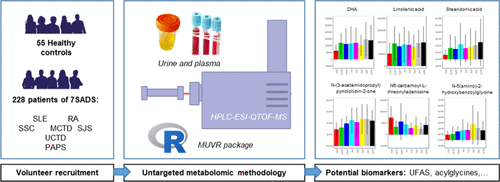当前位置:
X-MOL 学术
›
J. Proteome Res.
›
论文详情
Our official English website, www.x-mol.net, welcomes your feedback! (Note: you will need to create a separate account there.)
Metabolic Disturbances in Urinary and Plasma Samples from Seven Different Systemic Autoimmune Diseases Detected by HPLC-ESI-QTOF-MS.
Journal of Proteome Research ( IF 4.4 ) Pub Date : 2020-05-28 , DOI: 10.1021/acs.jproteome.0c00179 Álvaro Fernández-Ochoa 1, 2 , Carl Brunius 3 , Isabel Borrás-Linares 2 , Rosa Quirantes-Piné 2 , María de la Luz Cádiz-Gurrea 1, 2 , Precisesads Clinical Consortium , Marta E Alarcón Riquelme 4, 5 , Antonio Segura-Carretero 1, 2
Journal of Proteome Research ( IF 4.4 ) Pub Date : 2020-05-28 , DOI: 10.1021/acs.jproteome.0c00179 Álvaro Fernández-Ochoa 1, 2 , Carl Brunius 3 , Isabel Borrás-Linares 2 , Rosa Quirantes-Piné 2 , María de la Luz Cádiz-Gurrea 1, 2 , Precisesads Clinical Consortium , Marta E Alarcón Riquelme 4, 5 , Antonio Segura-Carretero 1, 2
Affiliation

|
Systemic autoimmune diseases (SADs) are characterized by dysfunctioning of the immune system, which causes damage in several tissues and organs. Among these pathologies are systemic lupus erythematosus (SLE), systemic sclerosis or scleroderma, Sjögren’s syndrome, rheumatoid arthritis, primary antiphospholipid syndrome (PAPS), mixed connective tissue disease (MCTD), and undifferentiated connective tissue disease (UCTD). Early diagnosis is difficult due to similarity in symptoms, signs, and clinical test results. Hence, our aim was to search for differentiating metabolites of these diseases in plasma and urine samples. We performed metabolomic profiling by liquid chromatography–mass spectrometry (LC–MS) of samples from 228 SADs patients and 55 healthy volunteers. Multivariate PLS models were applied to investigate classification accuracies and identify metabolites differentiating SADs and healthy controls. Furthermore, we specifically investigated UCTD against the other SADs. PLS models were able to classify most SADs vs healthy controls (area under the roc curve (AUC) > 0.7), with the exception of MCTD and PAPS. Differentiating metabolites consisted predominantly of unsaturated fatty acids, acylglycines, acylcarnitines, and amino acids. In accordance with the difficulties in defining UCTD, the UCTD metabolome did not differentiate well from the other SADs. However, most UCTD cases were classified as SLE, suggesting that metabolomics may provide a tool to reassess UCTD diagnosis into other conditions for more well-informed therapeutic strategies.
中文翻译:

通过HPLC-ESI-QTOF-MS检测到的来自七个不同系统性自身免疫疾病的尿液和血浆样品中的代谢紊乱。
全身性自身免疫性疾病(SAD)的特征是免疫系统功能异常,这会导致一些组织和器官受损。这些病理学包括系统性红斑狼疮(SLE),系统性硬化或硬皮病,干燥综合征,类风湿性关节炎,原发性抗磷脂综合征(PAPS),混合性结缔组织病(MCTD)和未分化的结缔组织病(UCTD)。由于症状,体征和临床测试结果相似,因此难以早期诊断。因此,我们的目的是寻找血浆和尿液样品中这些疾病的代谢物。我们通过液相色谱-质谱(LC-MS)对228名SAD患者和55名健康志愿者的样品进行了代谢组学分析。应用多元PLS模型研究分类准确性,并鉴定可区分SAD和健康对照的代谢物。此外,我们针对其他SAD专门调查了UCTD。除MCTD和PAPS外,PLS模型能够对大多数SAD与健康对照进行分类(roc曲线下面积(AUC)> 0.7)。差异代谢产物主要由不饱和脂肪酸,酰基甘氨酸,酰基肉碱和氨基酸组成。根据定义UCTD的困难,UCTD代谢组与其他SAD的区别不大。但是,大多数UCTD病例被归类为SLE,这表明代谢组学可能会提供一种工具,可以将UCTD诊断重新评估为其他情况,从而获得更明智的治疗策略。此外,我们针对其他SAD专门调查了UCTD。除MCTD和PAPS外,PLS模型能够对大多数SAD与健康对照进行分类(roc曲线下面积(AUC)> 0.7)。差异代谢产物主要由不饱和脂肪酸,酰基甘氨酸,酰基肉碱和氨基酸组成。根据定义UCTD的困难,UCTD代谢组与其他SAD的区别不大。但是,大多数UCTD病例被归类为SLE,这表明代谢组学可能会提供一种工具,可以将UCTD诊断重新评估为其他情况,从而获得更明智的治疗策略。此外,我们针对其他SAD专门调查了UCTD。除MCTD和PAPS外,PLS模型能够对大多数SAD与健康对照进行分类(roc曲线下面积(AUC)> 0.7)。差异代谢产物主要由不饱和脂肪酸,酰基甘氨酸,酰基肉碱和氨基酸组成。根据定义UCTD的困难,UCTD代谢组与其他SAD的区别不大。但是,大多数UCTD病例被归类为SLE,这表明代谢组学可能会提供一种工具,可以将UCTD诊断重新评估为其他情况,从而获得更明智的治疗策略。MCTD和PAPS除外。差异代谢产物主要由不饱和脂肪酸,酰基甘氨酸,酰基肉碱和氨基酸组成。根据定义UCTD的困难,UCTD代谢组与其他SAD的区别不大。但是,大多数UCTD病例被归类为SLE,这表明代谢组学可能会提供一种工具,可以将UCTD诊断重新评估为其他情况,从而获得更明智的治疗策略。MCTD和PAPS除外。差异代谢产物主要由不饱和脂肪酸,酰基甘氨酸,酰基肉碱和氨基酸组成。根据定义UCTD的困难,UCTD代谢组与其他SAD的区别不大。但是,大多数UCTD病例被归类为SLE,这表明代谢组学可能会提供一种工具,可以将UCTD诊断重新评估为其他情况,从而获得更明智的治疗策略。
更新日期:2020-05-28
中文翻译:

通过HPLC-ESI-QTOF-MS检测到的来自七个不同系统性自身免疫疾病的尿液和血浆样品中的代谢紊乱。
全身性自身免疫性疾病(SAD)的特征是免疫系统功能异常,这会导致一些组织和器官受损。这些病理学包括系统性红斑狼疮(SLE),系统性硬化或硬皮病,干燥综合征,类风湿性关节炎,原发性抗磷脂综合征(PAPS),混合性结缔组织病(MCTD)和未分化的结缔组织病(UCTD)。由于症状,体征和临床测试结果相似,因此难以早期诊断。因此,我们的目的是寻找血浆和尿液样品中这些疾病的代谢物。我们通过液相色谱-质谱(LC-MS)对228名SAD患者和55名健康志愿者的样品进行了代谢组学分析。应用多元PLS模型研究分类准确性,并鉴定可区分SAD和健康对照的代谢物。此外,我们针对其他SAD专门调查了UCTD。除MCTD和PAPS外,PLS模型能够对大多数SAD与健康对照进行分类(roc曲线下面积(AUC)> 0.7)。差异代谢产物主要由不饱和脂肪酸,酰基甘氨酸,酰基肉碱和氨基酸组成。根据定义UCTD的困难,UCTD代谢组与其他SAD的区别不大。但是,大多数UCTD病例被归类为SLE,这表明代谢组学可能会提供一种工具,可以将UCTD诊断重新评估为其他情况,从而获得更明智的治疗策略。此外,我们针对其他SAD专门调查了UCTD。除MCTD和PAPS外,PLS模型能够对大多数SAD与健康对照进行分类(roc曲线下面积(AUC)> 0.7)。差异代谢产物主要由不饱和脂肪酸,酰基甘氨酸,酰基肉碱和氨基酸组成。根据定义UCTD的困难,UCTD代谢组与其他SAD的区别不大。但是,大多数UCTD病例被归类为SLE,这表明代谢组学可能会提供一种工具,可以将UCTD诊断重新评估为其他情况,从而获得更明智的治疗策略。此外,我们针对其他SAD专门调查了UCTD。除MCTD和PAPS外,PLS模型能够对大多数SAD与健康对照进行分类(roc曲线下面积(AUC)> 0.7)。差异代谢产物主要由不饱和脂肪酸,酰基甘氨酸,酰基肉碱和氨基酸组成。根据定义UCTD的困难,UCTD代谢组与其他SAD的区别不大。但是,大多数UCTD病例被归类为SLE,这表明代谢组学可能会提供一种工具,可以将UCTD诊断重新评估为其他情况,从而获得更明智的治疗策略。MCTD和PAPS除外。差异代谢产物主要由不饱和脂肪酸,酰基甘氨酸,酰基肉碱和氨基酸组成。根据定义UCTD的困难,UCTD代谢组与其他SAD的区别不大。但是,大多数UCTD病例被归类为SLE,这表明代谢组学可能会提供一种工具,可以将UCTD诊断重新评估为其他情况,从而获得更明智的治疗策略。MCTD和PAPS除外。差异代谢产物主要由不饱和脂肪酸,酰基甘氨酸,酰基肉碱和氨基酸组成。根据定义UCTD的困难,UCTD代谢组与其他SAD的区别不大。但是,大多数UCTD病例被归类为SLE,这表明代谢组学可能会提供一种工具,可以将UCTD诊断重新评估为其他情况,从而获得更明智的治疗策略。



























 京公网安备 11010802027423号
京公网安备 11010802027423号